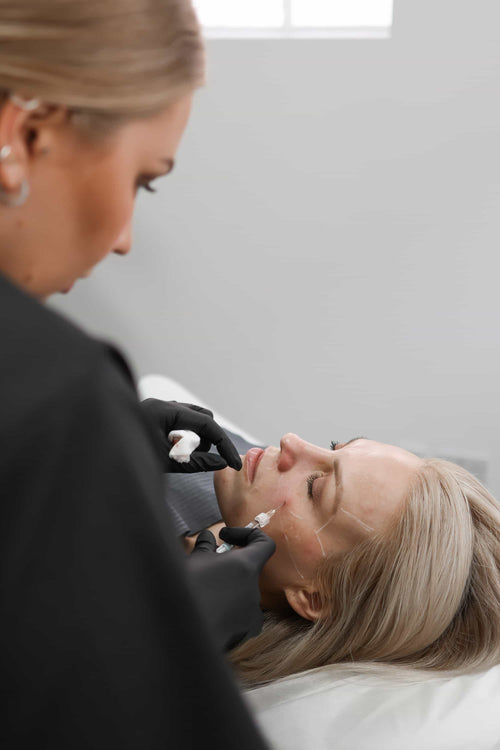Arrange a Dermal Filler Consultation at It’s Me and You Clinic with Dr. Laura Geige
Understanding Temple Fillers
The Anatomy of Eyelid Lift
Temple fillers can indirectly contribute to an appearance of lifted eyelids, but they don’t directly lift the eyelid tissue.
Here’s why:
**Understanding Temple Fillers:**
Temple fillers are injectable dermal fillers used to add volume and definition to the temples. As we age, our temples tend to lose fat volume, causing a hollow or sunken appearance. Temple fillers restore lost volume, creating a more youthful and balanced facial profile.
**The Anatomy of an Eyelid Lift:**
Eyelid lifts, also known as blepharoplasty, are surgical procedures that address sagging skin and excess fat in the upper or lower eyelids.

During surgery, a plastic surgeon removes excess skin and fat, tightening the underlying muscles to achieve a more youthful eyelid appearance.
**Indirect Lifting Effect of Temple Fillers:**
While temple fillers don’t directly lift the eyelids themselves, they can create an illusion of lifted eyelids in several ways:
- Improved Facial Balance: When the temples are filled, it creates a more balanced and harmonious facial contour. This can make the eyelids appear less droopy or hooded.
- Lifting Effect on Brows: By volumizing the temples, fillers can also subtly lift the brows, which indirectly helps to elevate the outer corners of the eyes, further enhancing the eyelid appearance.
- Skin Tightening Stimulation: Some fillers contain ingredients that stimulate collagen production, leading to mild skin tightening over time. This may contribute to a subtle improvement in eyelid skin laxity.
**Important Considerations:**
It’s crucial to understand that temple fillers won’t achieve the same dramatic lifting results as a surgical eyelid lift.
The effects of fillers are temporary and typically last for 6-18 months.
How Temple Fillers Work
Temple fillers are a non-surgical cosmetic treatment that involves injecting a gel-like substance, called a dermal filler, into the temple area to add volume and definition.
Understanding how temple fillers work can help determine if they are a suitable option for lifting eyelids. While temple fillers themselves don’t directly lift eyelids, they can indirectly contribute to an appearance of lifted eyes by addressing underlying facial concerns.
Here’s a breakdown of the science behind temple fillers and their potential impact on eyelid appearance:
- Dermal Fillers: Temple fillers typically contain hyaluronic acid (HA), a naturally occurring substance in the body that attracts and retains moisture. HA fillers are known for their ability to restore volume, smooth wrinkles, and enhance contours.
- Temple Area Volume Loss: As we age, the temple area tends to lose volume due to fat depletion and collagen breakdown. This can lead to a flatter appearance of the temples, making the eyelids appear heavier or droopy.
- Indirect Lifting Effect: By injecting HA fillers into the temples, the aim is to restore lost volume and create a more sculpted contour. This increased fullness in the temple area can subtly lift the surrounding tissues, including the eyebrows and upper eyelids.
The degree of eyelid lifting achieved with temple fillers varies depending on individual factors such as age, skin elasticity, and the amount of filler used. It’s important to note that temple fillers are not a substitute for eyelid surgery (blepharoplasty) if significant droopy eyelids are present.
Temple fillers can be a safe and effective way to achieve a more youthful and refreshed appearance by addressing volume loss in the temples. While they may indirectly contribute to an appearance of lifted eyelids, it’s important to manage expectations and consult with a qualified injector to determine if this treatment is right for you.
Benefits and Potential Risks
Lifting the Eyes: Realistic Expectations
Lifting the eyes through dermal fillers is a popular non-surgical approach to addressing concerns like drooping upper eyelids and brow asymmetry. It involves injecting hyaluronic acid filler into specific areas around the eyes to subtly lift and contour the skin.
A key benefit of this procedure is its ability to achieve noticeable results with minimal downtime. Unlike surgical eyelid lifts, which require incisions and a longer recovery period, filler injections are relatively quick and involve little discomfort.
The effects are generally gradual, allowing for subtle refinements as the filler settles into place. Additionally, fillers are reversible, meaning unwanted results can be dissolved using an enzyme called hyaluronidase.
However, it’s crucial to have realistic expectations about what fillers can achieve. While they can effectively lift and rejuvenate the eyes, they won’t completely eliminate excess skin or restore youthful firmness in a dramatic way.
The results typically last for 6 to 18 months, after which touch-up injections are necessary to maintain the desired appearance.
Potential risks associated with filler injections include bruising, swelling, redness, and tenderness at the injection sites. In rare cases, more serious complications such as infection or vascular occlusion can occur.
It’s essential to consult with a qualified and experienced injector who understands the intricacies of facial anatomy and can tailor the treatment plan to your specific needs and goals.
Open communication with your injector about your desired outcome, medical history, and any concerns you have is crucial to ensuring a safe and successful procedure.
Schedule a Dermal Filler Appointment with Dr. Laura Geige at It’s Me and You Clinic
Possible Side Effects

Temple fillers are a cosmetic treatment used to enhance facial contours, adding volume and definition to the temples. While they can potentially lift and improve the appearance of sagging eyelids by creating a more defined cheekbone structure, it’s important to understand both the benefits and risks associated with this procedure.
**Benefits**: Temple fillers can offer several aesthetic advantages:
• *Improved Facial Symmetry*: Fillers can help balance facial proportions by adding volume to sunken or recessed temples, creating a more harmonious look.
• *Enhanced Cheekbones*: Lifting the temples can create the illusion of higher cheekbones, making the face appear more sculpted and youthful.
• *Reduction in Sagging*: By adding volume, fillers can subtly lift drooping eyelids by supporting the surrounding tissues.
• *Non-Surgical Option*: Temple fillers are a minimally invasive alternative to surgical eyelid lifts, avoiding the downtime and risks associated with surgery.
• *Quick Procedure**: Treatment sessions are typically short, lasting only 30 minutes or less.
**Potential Risks and Side Effects**: Like any cosmetic procedure, temple fillers carry potential risks and side effects. These can include:
• *Inflammation*: Swelling, redness, and tenderness at the injection site are common side effects that usually subside within a few days.
• *Bruising*: Minor bruising may occur around the injection sites.
• *Lumps or Nodules*: In some cases, filler material can clump together, creating visible lumps under the skin.
• *Infection*: Although rare, there is a risk of infection at the injection site if proper sterilization techniques are not followed.
• *Allergic Reactions*: Some individuals may experience allergic reactions to the filler material.
• *Asymmetry*: If fillers are not evenly distributed, it can lead to an asymmetrical appearance. It is crucial to choose a qualified and experienced injector for optimal results.
It’s important to consult with a board-certified dermatologist or plastic surgeon to discuss your individual needs and expectations. They can assess your candidacy for temple fillers and discuss the potential risks and benefits in detail.
Alternatives to Temple Fillers for Eyelid Enhancement
Surgical Options
While temple fillers can certainly contribute to a more lifted appearance by addressing volume loss in the temples, they do not directly lift the eyelids. The skin around the eyes and upper lids is relatively loose and relies on underlying muscle tone and fat for support.
If you’re seeking eyelid enhancement beyond what temple fillers can provide, there are surgical options available:
- Blepharoplasty (Eyelid Surgery): This procedure involves removing excess skin and/or fat from the upper eyelids to create a more youthful and refreshed appearance. It can address drooping eyelids, wrinkles, and bags under the eyes.
- Brow Lift: Raising the eyebrows through a brow lift can have a cascading effect on the eyelid area, creating a more lifted and rejuvenated look. This procedure targets the forehead muscles and tissues responsible for eyebrow position.
It’s important to consult with a qualified plastic surgeon to discuss your specific goals and determine the best option for you.
A thorough consultation will involve:
- Evaluating your individual anatomy and concerns.
- Discussing realistic expectations and potential outcomes.
- Explaining the different surgical techniques and their associated risks and benefits.
Book Your Dermal Filler Session with Dr. Laura Geige Today
Choosing a skilled and experienced surgeon is crucial for achieving optimal results and minimizing complications.
Non-Surgical Treatments
Temple fillers can indeed contribute to an overall more lifted and youthful appearance by addressing volume loss in the temples, which can make eyelids appear droopy over time.
However, if you’re seeking eyelid enhancement without resorting to fillers, several non-surgical options exist.
One popular choice is **Botox**.
Injected into specific muscles around the eye, Botox can temporarily paralyze them, preventing the downward pulling that contributes to hooded or droopy eyelids. This results in a more open and lifted gaze.
Another effective option is **Ultherapy**, a non-invasive ultrasound treatment that stimulates collagen production in the skin.
By tightening and lifting the underlying tissues, Ultherapy can improve eyelid laxity and create a more defined browline, indirectly enhancing the appearance of the eyelids.
**Thread lifts**, often referred to as “lunchtime lifts”, involve inserting tiny dissolvable threads into the skin to lift and tighten sagging tissue.
These threads can be strategically placed in the eyelid area to address mild to moderate drooping and create a more youthful contour.
**Radiofrequency (RF) microneedling** utilizes fine needles that deliver radiofrequency energy to the skin, stimulating collagen production and tightening the tissues.
This treatment can improve skin elasticity around the eyelids, reducing the appearance of wrinkles and sagging.
Remember, the most suitable alternative to temple fillers for eyelid enhancement depends on individual needs, the severity of drooping, and desired outcomes.
Consultation with a qualified aesthetic practitioner is essential to determine the best approach for achieving your goals.
Crimson Hill Pets R4U K’s P Rules Cakes Emri Studio
- Why CBD Gummies Are A Great Option For Managing Symptoms Of Anxiety And Stress - November 10, 2025
- What Is The Best Filler For Sagging Cheeks? - November 9, 2025
- What Are The Benefits Of CBD Gummies For Weight Loss And Appetite Control - November 6, 2025
